
Flight Munich – Amsterdam – Nairobi 2017-05-07
Private homepage – Hans-Georg Michna
Kenya travel reports: 1999, 2000, 2002, 2003, 2004, 2005, 2006, 2007, 2008, 2009, 2010, 2011, 2012, 2013-Goma, 2013, 2014, 2015, 2016, 2017, 2018, 2019
Kenya Safari Travel Plan, Kenya 1980-2000 photos
Kenya 2017
A personal travel report from Kenya in May and June 2017
Last change: 2017-06-12 – Copyright © 2017-2023 Hans-Georg Michna
Click on the small pictures to see them enlarged, usually to 800 x 600 pixels.
Times are given in local Kenyan time in 24 h format (without "am" or "pm"), i.e. 0:00 to 23:59.
All photos are subject to copyright ©. If you want to reuse any photo, send me an email asking for permission, and I may send you the full-size photo, usually 3,264 x 2,448 pixels (8 Megapixels). These photos bear the copyright © 2017-2023 Hans-Georg Michna.
EXIF times in these pictures should carry proper time and time zone information. Kenya time is UTC + 3 h.
This web page is automatically reloaded with a date extension to its URL to defeat Safaricom's fraudulent proxy server.
[I use my latest camera—a Fujifilm HS50EXR. Most photographs in this travel report are reduced to 800 x 600 pixels and JPEG-compressed with medium strength to make them more palatable for the web.]
My Kenyan phone number, active while I am in Kenya, is +254724662096. It is good for SMS and calls, but the better ways to reach me are Hangouts, Telegram, Threema, WhatsApp, Wire, Skype, and email. For those chats that use telephone numbers as addresses, you may have to use my German mobile number +491793217777, which otherwise does not work while I am in Kenya.
My travelling checklist in michna.com/kenya.htm#Preparations (German version: michna.com/kenia.htm#Reisevorbereitungen) is, as always, my means of packing without fear of forgetting anything important. As usual, the packing and other preparations take at least a full day of concentrated work, because they cover an immense number of small things and details. Without the checklist I'd be lost.
KLM, Air France, and Kenya Airways on their flights to Nairobi currently allow two pieces of check-in luggage of up to 23 kg each in the economy class. KLM also has a pretty good and informative web site and a reasonably good smartphone app (click here for the Android version if you fly KLM), allowing ticket purchase, online check-in, and seat selection, now also for the flights operated by Kenya Airways and Air France.
I will meet friends and bring them smartphones. Article in German language about current smartphone choices
Our flight started relatively late this time. Departure time was only 9:25, which meant getting out of bed at 6:00, not at 4:00, like in earlier travels. This was nice.
The flight was entirely uneventful. Munich Airport seemed devoid of people at 7:30, so check in and security check had hardly anybody waiting at all.
A KLM Boeing 737 took us to Amsterdam over an almost entirely unbroken cloud cover.
We had only one hour to get to our next gate on the other side of the big airport in time for boarding, but to my surprise there was no security check and everything went very smoothly.
We used the free airport Wi-Fi to report our progress and soon boarded the KLM Boeing 747 "Jumbo" to Nairobi.
KLM allows the use of smartphones in airplane mode throughout the flight, even during takeoff and landing, so I could record both flight tracks, using the GPS in my phone and the powerful app Locus. I experimented with a battery-saving setting in this app that allows to let the phone sleep for some time, then wake up, fire up the GPS, record a trackpoint, and fall asleep again. Using this setting, I could easily record both flights, from time to time look at the map over interesting places, and still have ample battery charge on landing. During both flights only half the battery charge was used up.

Flight Munich – Amsterdam – Nairobi 2017-05-07
We arrived in Nairobi on time after a flight over Munich (only the clouds prevented a look down on our house), along the eastern coast of the Adria, Greece, Crete, along and over the river Nile to Khartoum, and on to Nairobi. We had beautiful views of Lake Nasser and the Nile.
After lining up at the visa counter, an official guided us away to the underused diplomat's counter, but even so we found some of our luggage already on the conveyor beld when we came down the stairs. The rest of the luggage arrived soon thereafter, and we headed for customs.
The customs officers randomly checked some less lucky passengers, but let us pass unhindered, so we were quickly out of the building and jumped into one of the waiting taxis.
After a fast drive we ended up in the Aero Club of East Africa on Wilson Airport, our Kenyan home base, at 23:00. We were greeted by the people who were still on duty, particularly the askaris (watchmen) and the barmen who served us a last drink for the day while chatting about their and our children.
The Aero Club of East Africa has been improved noticeably. The beds are nicer, and so we slept not too badly in the thin African highland air.
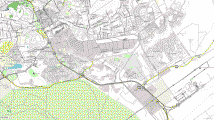
Drives in Nairobi from 2017-05-07 evening to 2017-05-10
Our first job on this Monday was to collect our car, this time a Toyota RAV4 4-wheel-drive. Our cars seem to become better and better every time, fortunately without becoming more expensive. Please see the extra chapter about the car at the end of this travel report, if you are interested in my judgment.
We took a taxi into town, which took much longer than it should, due to the unpleasant traffic jams that characterise Nairobi these days. We met the people running the car hire company and took possession of the car that was in very good condition. We filled in the paperwork, paid the monthly rent and left a deposit, which the car hire company required. And off we went with our new off-road car through Nairobi and back to the Aero Club.
Already in Wilson Airport we went to an ATM to test cash delivery through M-PESA. The procedure was needlessly awkward and required a phone call to a bank's support crew to find a required agent number, but it worked.
In the afternoon we met one of the most active bitcoin dealers of Kenya who came visiting us after we had already used his services last year and had built a good amount of trust. He supplied us with cash and filled up our M-PESA accounts (the widely used mobile payment system in Kenya). We had lunch together and enjoyed the afternoon on the Aero Clubs lawn.
We do the money transfer to Kenya Shillings through bitcoin, because the banks are far too awkward and far too expensive for our taste. Since there always seems to be a slight shortage of bitcoins in Kenya, we get an excellent rate at or above the global market rate.
In the evening a friend came visit and joined us for dinner. It was an enjoyable day. Despite reports of rain before our arrival and rain being forecast for this afternoon, we saw only a few drops, but quite a bit of sunshine.
Today we had three main tasks to do. First I went to the Aviation Medicine Centre to have my medical examination for the renewal of my Kenyan pilot licence. Then I had to go through the bureaucratic procedure to apply for the renewal of my pilot licence.
The oddest part was the payment. I received two filled forms, with which I had to walk to the Kenya Airport Authority cashier at the main airfield apron entrance. They took the forms from me and gave me two other forms. With these I had to walk over to a nearby bank, deliver the money in cash, and receive stamps and new forms.
With these I had to walk back to the cashier, who again swapped some forms and left me with one stamped form and a receipt. With these I went back to where I had come from, the KCAA licensing office, and deliver the form.
The problem that comes to mind is that my time is not worth very much here in Africa, so it feels normal here to waste it. Another expression is low efficiency. But the German bureaucrats are only somewhat better. When I think of the renewal of my international driver's license back home …
The evening belonged to another two friends of ours who came visit and joined us for an extended dinner.
Today should have been more lazy. The plan was to wander about the airport and find companies, probably flying schools, that had aeroplanes for hire. So I did, found four, and exchanged information.
One of the bigger and better ones had some interesting flight simulators, so I booked one for later, because I was curious and had never used any flight simulator, apart from the simpler ones that work on a personal computer.
We had some shopping to do, wandered through a big "Uchumi" supermarket near the airport, then came back for the flight simulator session.
The flight simulator was of the hydraulically suspended type that can simulate gravity shifts and accelerations by tilting the whole box. An instructor was there to explain the few differences to a real airplane and to control the simulation parameters.
He showed us the many capabilities. He even let it snow in Nairobi, which in reality never happens. Then I took the controls and did a few circuits, the last one in very low visibility, because I wanted to find out whether I would be able to control the plane and survive in such circumstances. I did survive.
Another incident may be worth telling. In the morning, when I drove across the airport to find the flying schools, a policeman stopped me, accused me of "obstructing traffic", and told me that I would have to go to court and pay KSh10,000. After these frightening threats he offered the friendlier alternative that I pay KSh5,000 to him on the spot and would be set free.
I already knew these tricks and began to negotiate at KSh1,000. He went down to 3,000, and, because I did not have much time to negotiate harder, I offered 2,000, which he grudgingly agreed to after a little while.
The new thing for me was that the policeman had conjured the accusation out of thin air. I had done absolutely nothing wrong. I had expected that they do this when they spot a light violation of rules, but as I now know, they can also do it already when somebody does something only slightly out of the ordinary, without violating any rule at all.
The oddest thing is that the same happened to me again a short while later. That time a policeman ordered me to pass another car that was standing in the way, and he also said that I should "pull out", which I misunderstood. So I passed that car and drove on, but the policeman stopped another car, jumped in and stopped me along the way.
At least that one was friendlier and, after I told him the story of his previous colleague, he said that he would not do this to me, as I had obviously not heard or misunderstood his command.
But in the end he said, "But you have to buy me lunch." I tried KSh1,000, he tried for more, but in the end he gave in and disappeared after asking me for my name and telephone number, so he could "be my friend."
Of course I could have tried to go free in both cases, but my problem was the lack of time to waste. Anyway, the lesson here is that it is best to pass these traps without doing anything even slightly out of the ordinary. And when they catch you, start negotiating low. I should have offered KSh500, rather than 1,000, then I might have made a trade for 1,500. And if you have lots of time, don't pay anything and agree to their proposal to go to court. They cannot be serious about that.
An evening in the Aero Club's bar among a bunch of very interesting people, many of them professional pilots, ended the day nicely.
Now it was time to leave Nairobi. We had a quick breakfast in the Aero Club's restaurant, then jumped into the car and drove off.

Nairobi – Amboseli 2017-05-11 and back 2017-05-14
Google Maps still does not know the new Southern Bypass road, but we knew it already. So getting out of Nairobi was very easy, apart from a bit of a traffic jam on the Mombasa Road.
After that driving was easy, but slow. There are many trucks, driving quite slowly uphill in the hilly area southeast of Nairobi, and there was quite a lot of oncoming traffic, so we could only occasionally overtake a few trucks before driving behind the next one. Thus our average speed was around 45 km/h while descending from the highest point at 1724 m above sea level down to an altitude of 1060 m.
Mombasa road is still in perfect shape, but its two lanes are insufficient for fast traffic. A four-lane freeway would cut travel time in half.
Just before turning off from Mombasa Road we drove into a petrol station and had a little repair done, tying up a dangling cable. We also filled our tank, because the fuel is more expensive inside the nature reserves. Then we turned off onto the C103 road towards Oloitokitok. This road was just as good as the Mombasa road. Although it lacked the repair strips on either side, there was almost no traffic, so we drove at 80 km/h on cruise control.
We passed the point where we had earlier turned off and entered Amboseli through Iremito Gate and continued straight to Kimana, a part that we had never driven before. It turned out that Kimana has two petrol stations plus another one a bit further on at the place where the dirt road to Amboseli branches off. I took the GPS positions of these petrol stations, and we continued towards Amboseli.
After a short distance we reached the Amboseli Sopa Lodge (formerly Amboseli Buffalo Lodge) and saw an aeroplane on its disused and unserviceable airfield. We drove into the lodge and asked for their prices, which were not particularly enticing. We did not try any harder negotiating though.
We also asked for the aeroplane, which turned out to be a private plane, owned and used by somebody who regularly uses the unusable airfield.
We continued to the AA Lodge just short of the Amboseli nature reserve, which we had already used two years ago with good success. The offered us the residents' rate right from the start, and we agreed and got a hut with two beds for KSh14,000, a bit more expensive than the last time, but acceptable.
We were again the only guests in this huge and well-maintained lodge and enjoyed our nice room, a drink in the bar, a walk around the lodge compound, checking the swimming pool, then a good dinner, and finally some rest at the open-air fireplace before going to bed.
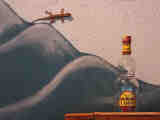
Gecko on wall painting in the bar of the AA Lodge
After a good breakfast at 9:00 we took our luggage back to the car, paid for the hotel night, and drove off towards Amboseli National Park. Its Kimana Gate is only 5 km from the lodge drive-in. We tried to find out the current conditions which always seem to change, and, true to form, they now no longer accept our US$ cash, even though the price is quoted in dollars. The only two accepted payment methods are the Visa credit card (I did not specifically ask for MasterCard, but they only mentioned Visa) and M-PESA.
We could use both, but my Visa card carries euro, not dollar, which would likely incur extra costs, so I chose M-PESA, which incurred an exchange rate loss of nearly 4%, due to the unfavorable USDKES exchange rate they demand. The incompetence is stunning. Who else stops accepting dollar cash to provide a dollar-denominated service? I cannot think of anybody or any company. The true cause of the incompetence may be that they could not manage to prevent their dollars from being internally misappropriated.
Anyway, we are certainly much more flexible than the Kenya Wildlife Service and entered the nature reserve for our first exposure to sights of plentiful wildlife.
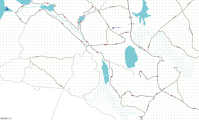
Amboseli 2017-05-12 and 2017-05-13
Because our car has a knocking noise on the rough roads, we went to the Amboseli Serena Lodge first, which lay more or less on our way, and checked at their petrol station for a car mechanic. There was one, but he was busy elsewhere in the lodge, so we gave up after a while, but not before asking for this lodge's prices.
They were also willing to give us the residents' rate, which was KSh8,500 per person. With this offer in our pocket, we drove on to our favorite, the Ol Tukai Lodge. There we received a similar offer, just slightly higher at KSh17,595 for a double room, also residents' rate, which we accepted for two nights.
We were still in time for lunch, which we enjoyed out in the open-air part of the lodge's restaurant. They offered a rich buffet with good number of choices for all courses.
After eating and resting we drove out for the rest of the afternoon. First we drove back to the Amboseli Serena Lodge and looked again for the local car mechanic. This time we found him and demonstrated the strange sound to him.
He crawled under the car and checked its underside. He found that one of the rubber parts of the exhaust holders was missing, causing the exhaust to swing much more than it should and knock against the body of the car. He could not repair it, but he bent the other holders a little bit to give the exhaust a bit more space, if only to prove that this was indeed the cause.
We paid him and drove off along the eastern side of the Amboseli swamp, north to the Sinet Causeway, then back to the lodge, and took some photos.
Sometimes flamingos come to Amboseli.
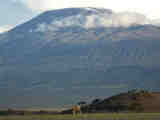
Gnu in front of Observation Hill, in front of Mt. Kilimanjaro
Finally a good dinner rounded out the day.
After breakfast we drove around the northeastern part of the Amboseli swamp. A few photos:
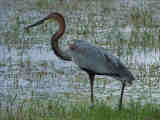
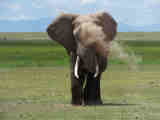
Goliath heron; young elephant bull, dusting himself
I found that quite a few narrow tracks I used to know, that were created by cars, had been changed into graded dirt roads wide enough for two cars side by side. I cannot detect any purpose in this, as the original tracks, where grass grew between the two parallel tire tracks, served their purpose well and had only a minimal impact on the vegetation. Who knows what they are up to?
We had lunch from the buffet, essentially a five-course meal like dinner, consisting of starter, soup, main course, dessert, and finally coffee and crackers.
In the afternoon we were offered some tea by the crew of the elephant research camp, so we chatted with them for a while, then set out for a short evening drive.
This was surprisingly successful, because we saw our first lion this year, a magnificent male with a dark-brown mane.
The elephant in the swamp vegetation behind the lion was not as close as the telephoto lens makes it seem. She had not noticed the lion, otherwise she would not have kept foraging quietly, but would instead have alarmed the others in her group (not visible on the photo), and they might have gone away or chased the lion.
Should I keep mentioning the good dinner? I think, Ol Tukai Lodge is a first-class wildlife lodge of very good quality throughout. Recommended.
We had planned to go back to Nairobi today, so we had breakfast, then jumped into our car and drove off. Due to recent rains we did not expect Lake Amboseli to be drivable, so we drove around it on the usual unpaved road no. C103 towards Meshenani Gate and Namanga.
Shortly before the gate we could oversee the whole lake and saw that it was partly filled with water.
I was curious how our Toyota RAV4 would behave on this rough road, and it worked very well. Apparently the road had been graded in one of the last years, and the good suspension of the car and its relatively big wheels made driving fast and pleasant.
The road from Namanga to Athi River is paved and was in very good condition. It is a two-lane highway with repair strips on both sides.
We saw a repair team with Chinese foremen fixing some damage to the road.
We visited friends in the Kajiado area, then continued to Nairobi.
When we drove into Wilson Airport, we were stopped just before the entrance barrier by two young policemen and one policewoman. They demanded my driving license, then stated that my German-issued international driving license is invalid, because it does not contain a list of the contries for which it is valid.
This is, of course, nonsense and only yet another attempt to extort money. But we remained insistent, showed them both our licenses and also my Kenyan pilot license, and eventually they gave up and let us go without payment.
This shows that behaving perfectly normally does not protect anybody from being harrassed by some corrupt Kenyan policemen.
We got up early, because we had arranged for a workshop appointment with the car rental company because something rattled underneath the car on rough roads.
After a quick breakfast we drove across the Nairobi city center, which is an adventure because of dense traffic jams and the Kenyan driving style, which I have still not fully acquired. Trying to keep collision risks down to German levels means that I frequently get into situations where I cannot move and keep having to yield.
But eventually we reached the office of the car rental company and handed the steering wheel to our contact person. He drove the car into a street with several shops for car-related products and called the car mechanic and his assistant.
There was no workshop. The work was done in the street. They checked various parts and determined that both front shock absorbers were defective. New ones were bought from a nearby shop and the defective ones were replaced.
This took several hours. Shortly before noon the work was finished, and we drove out of Nairobi.

Nairobi – Masai Mara 2017-05-15 and back 2017-05-22
Soon we reached the turnoff towards Mai Mahiu into the Rift Valley and drove down with a magnificent view across the valley on our left.
In Mai Mahiu the road to Narok begins, and we crossed the Rift Valley, passing the Mt. Suswa volcano.
Soon we reached Narok, the last city on our route. There, at the petrol station just after the bridge, we filled our tank, had a little lunch in the restaurant at the petrol station, and asked around for anybody who had very recently driven the route via Lemek and Aitong to Talek. I greatly prefer that route over the standard one to Sekenani Gate, which is very rough and dusty.
I did not expect the Lemek – Aitong – Talek route to be drivable, but then I found a driver who had come on this route and assured me that it is perfectly drivable and that even two-wheel-driven limousines were able to pass it. So we changed our plans and drove towards Lemek, first on a perfectly paved highway, then on a sandy track, and finally on the only bad part, a very stony, rocky stretch on which we could only drive very slowly, often less than 20 km/h.
In some places there were tracks beside the road, so we drove on those wherever we could. At one time we drove on such a track through a line of bushes, when suddenly there was a barrier made of one pole and a tree trunk positioned in the middle of a gate through a wooden fence. A boy, perhaps 10 or 11 years old, came to us and demanded his road tax.
This was so funny that I gave him KSh50 for his entrepreneurship. He cleverly tried to trade us up to KSh100, but he was a bit too careless, so I could quickly pinch the KSh50 bank note from his hand.
That tilted the negotiations in our favor, and he agreed to remove the barrier for KSh50, but not without announcing that at this price he would charge us again, should we come back the same way.
Of course this was more a joke and a child's game than any serious hindrance, because we could have gone out and removed the barrier ourselves, but we gladly played the game in recognition of the boy's business sense.
After leaving the rocky road and turning left just before Aitong the road became much better, and we could continuously drive almost all of the way at the relatively high speed of 50 to 60 km/h.
Thanks to the good car we could drive the entire distance in less than 6 hours, for which we had planned 8 or 9 hours in recent years. We reached Talek at 18:00 and drove straight to the northern entrance of the Fig Tree Camp, where we were greeted by the crew as old acquaintances. After moving into one of the nice tents we were rewarded with a good dinner.
Mausi got sick, stopped eating, and stayed in bed. She suspected that the chicken she ate in Narok was bad.
So, after making sure she had everything she needed, I drove out alone for a late-morning drive on the northern side of Talek River.
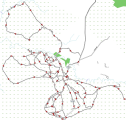
Masai Mara 2017-05-16 to 2017-05-21
The drive was quite successful, I passed near Ol Kiombo airfield, checked, but could not pass, the Double Crossing, and saw a lot of interesting animals.
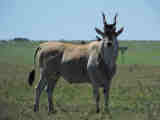
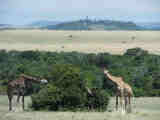
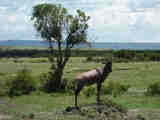
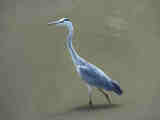
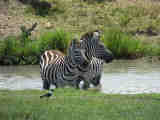
Eland bull; Maasai giraffes; topi; grey heron; zebras
Mausi recovered, and in the late morning we drove around a little along Talek River. There were lots of zebras, Thompson gazelles, impalas, topis, even a big eland bull. Photos:
In the late afternoon I drove out again and moved in a southerly direction. I found a place again that had been difficult to access in previous years because of high grass and mud. This year it was relatively easy to get to, apart from some mud holes, but I could not drive across the place because the tracks I remember from a long time ago were no longer visible under the fresh, green grass, and there was always a risk of hidden mud holes.
But the landscape was incredibly beautiful in the evening sun, and I saw large herds of topi, impala, Thompson gazelle, and others. On the way south I tried to take photos, but photographing the impression of the sight of a large herd of animals is difficult. On the way back I could no longer take photos, because so much mud from difficult crossings had splashed onto the windows that I did not dare to open them and thus pull the mud into the doors. So no photos from this beautiful drive.
In the evening two thunderstorms passed by. Both missed us, but we still got some rain.
When we looked out of our tent and down into the river, we saw a hippo just opposite, sleeping in the morning sun.
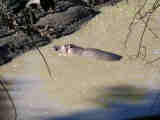
View down to Talek river rom the terrace in front of our tent: a hippo
After breakfast we set out on a late-morning drive. Because of last night's rain many places were still wet and slippery, so we did not move very far. We found a bunch of ground hornbills, intelligent birds with a life expectancy of over 30 years.
Our afternoon drive did not yield many photos, but among many other animals we saw striped mongoose, which are very shy and therefore difficult to photograph.
In the morning we had hardly left the camp when we stumbled upon this scene:
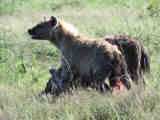
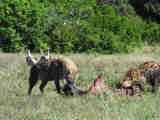
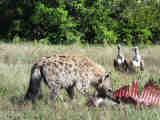
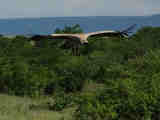
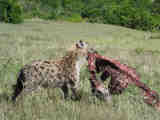

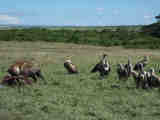
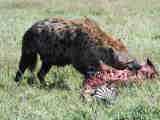
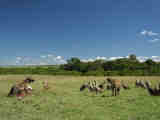
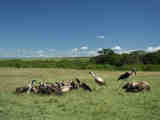
Hyaenas, vultures, a marabu stork, and a dead zebra
Lions had killed the zebra in the middle of a hyaena clan territory. So the hyaenas had come in numbers and chased the lions away.
After the hyaenas had toted the zebra carcass away piecemeal, we left the scene and looked for other interesting animals.
We found a cheetah mother with a cub, lying in the shade under a bush, looking intently at a group of Thomson gazelles. After some time she started a hunt and raced into the gazelle herd. This is only the second time I have seen a cheetah hunt and the only time I saw one running at full speed.
But the gazelles spotted her too early, they were all fully grown and also very fast. So the cheetah quickly gave up after noticing that none of the gazelles stayed behind.
Because the cheetahs ran past our car very quickly and unexpectedly and away from our car at high speed, there was no chance of taking a photo, and even if I could have taken one, not much would have been visible on it.
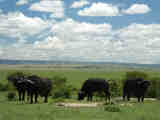
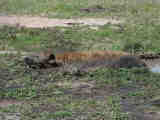
Buffalos, hyaena taking a mud bath
In the afternoon we saw buffalos, among many other animals, and then another cheetah mother, this time with two cubs.
As usual we did one drive in the late morning:
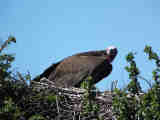
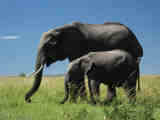
Vulture; elephant mother with child
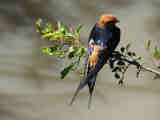
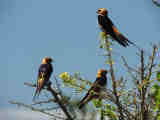
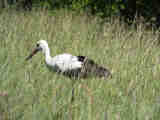
Swallows, European white stork
And another drive in the late afternoon:
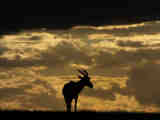
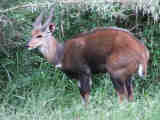
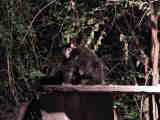
Topi at sunset; male bushbuck; bushbaby
The bushbuck was just across the river from our lodge. The bushbaby is fed every evening at the lodge.
In the morning we went to the hippo pool again to take a few more hippo photos.
In the afternoon we visited a research camp and took these photos along the way.
Our planned time in Masai Mara ended. So we got up around 6:00, packed our things, and went for our last breakfast. Finally we said goodbye to the lodge staff and drove out at 7:30.
Again we took the already tested route via Talek Gate – Aitong – Lemek – Narok – Mai Mahiu – Nairobi. We took a 15-minute break in Narok at the Kenol petrol station down by the river. Arriving in Nairobi, we used the new and very fast Southern Bypass four-lane freeway and arrived at the Aero Club of East Africa around 14:15. This means we had a pure travelling time of 6:30 hours, which is a lot better than the 8 to 9 hours we needed on the Sekenani Gate route with a Suzuki Maruti Gypsy.
The Toyota RAV4 can be driven much faster over medium-rough roads, due to its better suspension. On very rough, rocky stretches, like between Lemek and Aitong, we still had to drive at around 15 km/h, but on gravel roads with medium roughness and without holes and ditches the bigger wheels and the softer suspension often allow speeds above 30 km/h without any big stress to either the car or the passengers.
In the late afternoon we received friends and had dinner with them, which was one reason why we drove back to Nairobi at all, rather than going directly to Nakuru. Another was that I wanted to collect my renewed pilot license, but that failed—it was not ready yet. Bureaucracy …
The drive to Nakuru was fast and uneventful. Fast is a relative expression, because on the two-lane highway there is quite a bit of truck traffic, so part of the way one is driving behind a truck, waiting for the not too frequent opportunity to overtake safely.
Usually I was overtaken by two or three Kenyan vehicles before I overtook the truck in front of me, but that is apparently because I value my health and life more highly than many Kenyan drivers.
On one occasion I saw a Kenyan car overtake shortly before a hilltop, where a fast oncoming car would have led to a frontal crash with at least two instant deaths. The driver was just lucky—there was no oncoming car, but he could not have known.
Another problem is that even on level roads the trucks are slow, often driving only around 60 km/h. I don't know why this is so. Perhaps they are equipped with speed governors like the Germany ones, but set to a lower speed.
But apart from these small difficulties the drive was enjoyable. The road led us along the eastern edge of the Great Rift Valley and later down into it, past three big lakes to Nakuru.
We took a room in the Nuru Palace Hotel and met with friends there. The hotel has a small restaurant, so we were not missing anything.
After a late breakfast we took off for Eldoret, which lies in the western high plateau of Kenya. so the road took us again higher and out of the Rift Valley. The road was in excellent shape, like the one we had driven yesterday, and the landscape was beautiful.
When we were driving on the street that leaves Nakuru towards Eldoret, an accident happened directly in front of us. Two motorcycles collided, and one fell over, its plastic windshield shattering. Being a good German, I stopped and joined the discussion between the drivers and a few other people on the scene. Fortunately the victim of the accident was only lightly hurt.
What happened was that the first one tried to overtake a car, when the second drove up dangerously close and collided with the first when it began to overtake and moved right. (In Kenya one drives on the left side.)
I offered my opinion that the second motorcyclist was at fault and had caused the accident. I gave the first motorcyclist my card and offered myself as a witness, but I soon realised that the last they would do is call the police.
Still my intrusion helped the victim to negotiate a compensation for the damage to his motorcycle, as I later learned.
By the way, the first motorcyclist had also been driving dangerously, far to close behind the car in front, but in the case that did not cause the accident.
Western Kenya is fertile, particularly during and after the rainy season. Everything looked lush and green.
After about 3½ hours we reached Eldoret and our first hotel option, the Hotel Baron, right in the center of the city.
Parking was impossible, and we did not like the hotel very much, so we drove back out to another one outside the city center, the Boma Inn. This is much more expensive, roughtly European prices, but it was altogether so much nicer that we did not think twice about it and asked for a room.
After I had told the receptionist that we wanted a room for one night only, she said that we were lucky, because tomorrow the hotel was fully booked, but for today she could still find a room for us.
This is a new twist of the old story. In most hotels and lodges so far they had told us that they were fully booked last night, because of a conference or some such. Here the receptionist took slight risk. If we would unexpectedly change our plans and ask to stay longer, the story could blow up in her face. But then she could still invent another story and tell us that the conference was delayed or some such.
The hotel is of pretty good quality, architecturally comparable to fine hotels in Europe. The air conditioning did not work in our room, but Eldoret is not so hot that we would need one. They brought us a fan.
One lapse happened in the restaurant. We ordered chicken soup and got it, but it was so extremely spicy hot that we both could not eat it.
But they quickly corrected that mistake and made new chicken soup for us, which was excellent and free of chili. So altogether we cannot complain.
Other lapses were inconsequential for us, but are interesting from our developed-country point of view. By far the biggest was that our room had a small fridge, which had been put into a small cabinet. To facilitate hot air circulation, the rear panel had rows of big holes.
However, the fridge was not fixated inside its box and could be shifted anywhere. We found it pushed against the rear panel, blocking all cooling openings. When we opened the cabinet door, it was hot in there, and the inside of the fridge was not very cold.
I would like to know how much electricity the entire hotel is wasting, if all the fridges in all rooms work continuously against the well-insulating wood around them.
In my experience, explaining this to anybody in the hotel is ineffective. I could try, but I already know that I would find everything unchanged next year.
Other small lapses were that the mechanism to open and close the windows was falling apart with loose screws, that one of the three shower liquid dispensers did not work at all and consequently was completely full, that Mausi ordered fried eggs, but got an omelett (no problem—she likes that just as much), and that the Wi-Fi was both misconfigured and had an unstable back-end connection. This last point is probably due to the service provider, because it is almost universal in Kenya.
But altogether these were minor points that hardly diminished our enjoyment there. The Boma Inn is still among the very best hotels in Kenya. The lapses are just instructive and should be interesting for anybody investing in Kenya.
Our very beautiful route led us through Tambach on the edge of the Kerio valley, through the valley, up the mountains on the other side to Kabarnet, then again down into the main Rift Valley to Kampi ya Samaki, which I usually and not quite correctly call Baringo. (Baringo is actually the whole province.)
The views are absolutely breathtaking. We passed the high waterfall that falls off the edge of the Eldoret plateau and could oversee the mountainous edges of both valleys and the landscape in the valleys from high up.
Deep down in the Kerio Valley there is the deep Cheploch Gorge (also called Chebloch Gorge) with water flowing through it.

Cheploch gorge in the Kerio Valley
The road was in perfect shape, through not very wide, but there was very little traffic on it, so we arrived at Roberts Camp in Kampi ya Samaki in good shape and moved into our small banda (hut).
We visited friends in two different places nearby. The second place was particularly thrilling, because hippos grazed on the lawn. We had to be very careful to walk the 30 m from the house to our car, so as not to be attacked and chased by a furious hippo trying to defend her child.
Finally we came back into the Thirsty Goat restaurant on the camp site for a good and plentiful pizza dinner.
We went into our little banda, a round hut with a double bed, a big mosquito net, a toilet and a shower, and soon went to sleep in the knowledge that we would have to rise early and drive a very long distance tomorrow.
At around midnight I woke up because something apparently bit into my knee. It felt like two bites a centimeter apart, which I found very peculiar. I grabbed my phone and lit up its torch, but could not find anything that could have tried to bite me. I also did not find any sting and it did not hurt. So I went back to sleep.
At 2:00 the same happened again, so I began to search more thoroughly. Mausi also woke up and helped searching.
Then we found the culprits. Three cockroaches were crawling along the top of the mosquito net. We carefully chased them out, one by one, and I checked how they could have entered in the first place.
Sure enough the mosquito net was not enclosing the bed properly, so they could crawl in at one or two places on the ground and then probably could not get out again, but instead began to crawl up my body, touching be with both pointed, hooked foreclaws. This must have been what I had felt.
We fell asleep again and had some remaining good rest without any further attacks from anything, leaving us sufficiently refreshed for the next day's long drive.
This was going to be a long travelling day. Google Navigation had calculated about 6½ hours to drive the route Baringo – Nakuru – Nyahururu – near Nyeri – Nanyuki – Isiolo – Archer's Post – Archer's Post Gate – Samburu Lodge. Normally we prefer the more direct northern route Baringo – Loruk – Tangulbei – Churo – Mugie – Kisima – Lodungokwe – near Wamba – Samburu West Gate – Samburu Lodge, but northern Laikipia has recently become a dangerous place with Pokot and Samburu warriors attacking farms and killing people to let their cattle graze there. I would not like to meet armed marauders on the road.
Our way led us past huge sisal plantations.
Sisal grows, then blooms once, then dies, similar to bananas. This field was blooming.
Google Navigation failed in mysterious ways after trying to lead us on a shortcut over unpaved and eventually unpassable tracks. It offered us a nonsensical alternative. The proximate cause may have been that the optimal road was being repaired at its very beginning with a short diversion that Google did not know. Nonetheless it eventually showed that road after we had given up on those shortcuts, and I spotted the diversion before Google could lead us past it to the turnoff that was completely blocked. I guess, Google has some work to do on recognizing routes that nobody drives on versus routes that everybody drives on.
We had lost some time on the false shortcuts, but mostly we were slower than Google's predictions, which seem to ignore both our actual travelling speed and the general speed that can be driven on these roads.
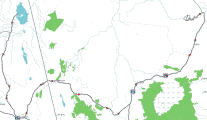
Baringo – Nakuru – Nyahururu – Nanyuki – Isiolo – Archer's Gate – Samburu
2017-05-26
We had a short rest at our favorite restaurant, Barney's Bar, on Nanyuki Civil Airport, ate some soup and drank something, then continued north.
After 10½ hours we reached our destination, Samburu Lodge, just before sunset and had some cold drinks and later a good dinner with a friend who lives there and runs a research project on reticulated giraffes, a rare species that exists only in Samburu and nearby.
This was a quiet day of resting and meeting people. The sun relentlessly beamed down from the clear blue sky, raising the temperature to above 33°C. I drove out in the evening for a very short drive, but it was already too dark for photos.
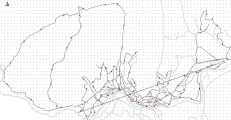
Samburu 2017-05-27 to 2017-06-03
The straight line in the tracks above is an incomplete recording of the car ride after the flat tire back to the Save the Elephants camp (see below). No, in fact we did not fly, although it looks like that. In fact we drove along the main track.
In the early morning I heard three gunshots, probably from the other side of the river, i.e. the Buffalo Springs nature reserve. That area had already entirely been taken over by herders last year, so it can no longer reasonably be called a nature reserve.
There is currently tension between the tribes of Turkana and Samburu, so the suspicion is that they shot at each other along some dividing line.
We drove out after a late breakfast and took some photos. Unfortunately the Samburu nature reserve is now also heavily infiltrated by herds of cattle, goats, and sheep, which can be driven through the river that has hardly any water.
So wildlife is once again on the defense. We still managed to see some wild animals. Photos:
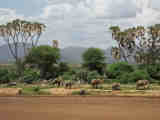
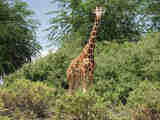
Elephants; reticulated giraffe
Later we drove away from the river into the dry areas to the north.
Back in the lodge we saw this creature while having lunch. It is an agama species, quite common in the warm and dry areas of Kenya.
Later in the afternoon a thunderstorm moved past and brought some medium-heavy rain that lasted for about an hour. We were told that it had not rained like this here for over a year. To avoid getting stuck in mud we did not drive out after the rain, which gave me the time to continue to write this report.
The river had almost dried out and carried only a tiny amount of water. In the evening, however, suddenly a wave rushed down the riverbed, then a second and third one. After a short time the river was full of water, which rushed down with loud noise, and we began to think about emergency measures, should the flood rise even higher.
Fortunately it didn't, and we had dinner and chatted with our friend, the researcher and zoologist, two science reporters, and a two-person film crew doing a wildlife documentary for Sky.
We had a late breakfast and a lazy morning, filled with chatting and resting. But after lunch and another resting time we drove out to see some animals. Here is a small selection.
We happened to see this pair of Bateleur eagles, a big bird of prey that has almost no tail. Some more pictures:
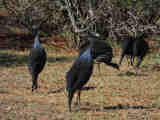
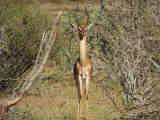
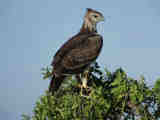
Vulture-headed guinea fowls; gerenuk, young martial eagle
Today I concentrated on two gazelle species, the dikdik and the gerenuk. Dikdiks are very common here. Gerenuks are not quite so common, less than impalas, for example, but they give this area a distinction. First the dikdik, which, I think, is the smallest gazelle in the world:
Dikdiks are not dependent on an open water source. I believe they get enough water by licking morning dew.
The gerenuk has a unique behavior when feeding. It can stand up on its hind legs, resting its forelegs against a bush, and thus being able to feed much higher up than all other gazelles. Only giraffes and elephants manage to feed even higher.
Around sunset I found and watched three cheetahs that were trying to make one last kill before nightfall. Cheetahs, unlike all other large mammalial predators, are diurnal. They need the daylight for their incredibly fast sprints.
In the morning I saw a young monitor lizard on the lodge compound and could take photos.
Later, during our late-morning drive, we saw a fully grown, male waterbuck, among other photogenic animals.
The drinking impala buck illustrates why the rainy season is hard for lions and to some extent other large predators. There are many sources of water, even in higher areas, so the herbivores do not have to come down to the dry-season water sources, but can instead spread out over a much larger area. Thus the simple lion strategy of waiting at a water hole no longer works as well as it does during the dry season. More photos:
Today we inserted some rest and some other activities and only drove out with the giraffe researcher in the afternoon to find and document giraffes.
They were often difficult to find and see, so here is just one photograph to provide an idea of the situation.
Photos from this morning's drive. In the afternoon I did not take any photos.
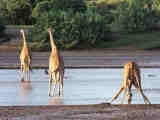
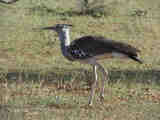
Reticulated giraffes, one drinking from the river; Cory bustard
In the evening we had invited the elephant research team over to our lodge for dinner. We had a lot to talk, got to know them better, and learned a bit more about the situation in the nature reserve, particularly about the elephants.
Today we joined an elephant researcher in her car, a modified Suzuki Maruti Gypsy, completely open, only with a sun roof. I liked that car.
She lives in the nearby "Save the Elephants" camp and had offered to take us along on her regular elephant observation tour through the reserve.
We found part of a family group, standing in the shade and guarding a sleeping baby. Elephant babies regularly fall asleep a few times during the day. The mother and other members of the group then stand next to the sleeping baby, giving shade if necessary and guarding the baby.
The researcher knew the elephants well and they knew her and the car, so she could drive very close to them without alarming them. The second picture shows part of our car for reference, but the wide-angle lens makes the elephants look farther away than they really were.
We drove on and saw two elephant bulls on the other side, one of whom was known to love cars and often come very close. Then a third bull, who was in musth and covered in white dust typical for an area in the east, marched by at a relatively brisk pace. When we tried to follow him, we found that our rear right tire was flat.
We jumped out of the car and changed wheels, only to find that the spare wheel was also completely flat.
So we called for help. A pump could solve our problem for now. At this time the car-loving elephant bull showed up in the nearby bushes and the researcher asked us whether we would feel uncomfortable if the elephant bull came very close and touched the car, because then she would try to drive away on the rim. We assured her that we would not be afraid, and I was looking forward to a very close encounter.
However, the elephant bull moved away, perhaps because he had smelled the musth bull who had passed nearby and became a bit unsettled himself.
Two people from the camp arrived and brought an electric pump, with which we could quickly pump up the tire and drive back.
Today we began to travel home, first to Nairobi, then, tomorrow, back to Munich. We got up around 6:00, packed the last few things, went for a little breakfast, said goodbye to everyone, and left.
On our way to Archer's Gate and Archer's Post we spotted first one, then a second male lion, probably two of a group of four that had recently migrated to Samburu.
This was a nice goodbye from Samburu and lifted our spirits. It is good to see that some large, iconic animals can still make a living in this age of ever-shrinking space for wild animals.
After passing Isiolo and Nanyuki we made an early lunch stop at Barney's Bar on the Nanyuki Civil Airport, 20 km south of Nanyuki. Then we continued to Nairobi in light traffic and arrived shortly after 3:00 at the car rental office. Their driver then took us to Wilson Airport and took the car with him that had served us well through these four weeks.
We had one last dinner in the Aero Club of East Africa, said goodbye to everybody we knew there, and went to bed as early as possible after setting our alarm clocks to 3:30.
The night was short, but long enough to get at least some sleep. Our taxi driver came in time. At this time there was no traffic, so we reached the international airport quickly.
Check-in was also quick. Most travellers had not arrived yet. But in Nairobi it is better to be at the airport early, because you can never know what would happen.
We took our seats in the Boeing 787-8 "Dreamliner" and looked out of the window to see Nairobi disappear behind us. We passed Mt. Kenya again, then Lake Turkana, then Khartoum. We flew on an easterly route along the river Nile and could see it very well from high above.
Later the Mediterranean Sea came into view. We crossed it and flew somewhere between Turkey and Greece.
We passed north of Munich and finally reached Amsterdam Schiphol airport after this beautiful and comfortable flight. I had almost watched 4 movies during the flight and checked some for their suitability for the home cinema.
The downside of the Boeing 787 is that the fuselage is electrically shielded such that mobile phone signals are weakened, but still work (on the ground), but GPS signals are apparently weakened so much that I could not receive a single satellite and thus have no GPS track of this flight.
We had plenty of time and strolled across the airport and its shops. Eventually boarded a Boeing 737 to Munich and arrived there 20 minutes early.
Georg collected us and our luggage. We drove home in continuous rain and cool temperatures, but still in good spirits. We went to bed early to avoid any large jet lag shifts, but even this one-hour time shift plus the fact that we had usually gone to bed early in Africa creates a bit of a jet lag effect.
It is nice to be home again, but I am still stunned at how quickly the four weeks had passed. I could easily have stayed another four weeks without getting the feeling that I have to go home.
I will complete this short appreciation of this type of car after we finish our driving, but I can already say that the suspension, the continuous (stepless) automatic transmission, and most other details like the air conditioning were excellent.
Because of its continuous (stepless) automatic transmission and its always engaged four-wheel drive this car needs no extra controls for slow and fast gears. It also has no differential lock. Apparently it does not have limited-slip differentials either, but other cars in this price class also don't have them, so I cannot complain. For most light off-road driving purposes these are not big problems, and I had several difficult situations, which the car mastered well. I guess, if one wheel were hanging completely free in the air, then the car would not be able to free itself, but such situations can usually be avoided either by driving elsewhere or by using some momentum.
The biggest downside seems to be the lack of a roof hatch. The roof hatch is almost a requirement for wildlife safaris where one often needs a high vantage point to observe and take photos. Of the cars we had used, only the Suzuki Maruti Gypsy was available in a version with a large roof hatch.
Another problem is the insufficient ground clearance under the motor's oil sump, particularly because the car is quite wide.
Unfortunately our car also did not have off-road tires, so its ability to negotiate difficult terrain, particularly mud, was somewhat reduced, but proved adequate for our purposes. I guess the actual difference between different tire types is not that big. Perhaps it could have been a problem, had we tried to drive through large, deep mud holes, but we avoided that.
Something underneath the car and another thing under the hood kept knocking on rough, stony roads. The knocking from below was apparently caused by a missing or bent piece that should hold the exhaust. This was quickly repaired, so the knocking against the bottom of the car ceased completely.
However, none of three car mechanics we asked was able to find out the cause of the knocking under the hood, much less repair it. I suspect that something is misdesigned, perhaps because the car was tested only on smooth roads. But since the car mechanics assured us that all essential elements, like wheel attachment and steering, were good and functioning well and since the knocking occurred only on fairly rough, stony roads, we did not bother any more about it.
Despite its shortcomings the Toyota RAV4 4WD may still be the best choice among the available cars in this price class in Kenya, simply because the car rental companies do not have any cars that fulfill all requirements. The bigger cars that do are needlessly big and much more expensive for reasons unrelated to our requirements. I will keep looking for a car with a roof hatch and larger ground clearance.
Some functions of the car are misdesigned. For example, the cruise control has an unnecessary button and needs more manual interactions than are necessary for its function. Any such distraction for the driver reduces the safety, so this is actually more severe than it first seems, but it does not concern us during a Kenya safari.
The car also has a penchant for incessant beeping without any readable explanation, so we found ourselves pushing buttons and shifting levers until we found out what the car disliked. Apparently it beeps when the transmission control lever is not in the parking position, when not all doors are locked, when the electrics are not switched off, etc. But when we accidentally left a reading light on in the parked car, there was no beep. Somebody alerted us to the potential battery killer.
The car also keeps beeping as long as the seat belts are not put on. I would find it acceptable if the car warned me about the belts, even if it beeped for a minute, but beeping forever is incredibly idiotic. Who would want that? On our slow wilderness drives we do not use seat belts, and so we pulled the belts behind the backrest and closed them to keep the car quiet.
I can rent this car and put up with its idiosyncrasies for a while, but I'm not sure whether I would buy it.
If in this text you find any typos, orthographic errors (even small ones), ungrammatical sentences, wrong or illogical information (like wrong names of birds), if you want me to write more details about something in particular, or if you want one of the photos in full resolution, please click on the email sign below and write to me. Many thanks!
Copyright © 2017-2023 Hans-Georg Michna.
Private homepage – Hans-Georg Michna
Kenya travel reports: 1999, 2000, 2002, 2003, 2004, 2005, 2006, 2007, 2008, 2009, 2010, 2011, 2012, 2013-Goma, 2013, 2014, 2015, 2016, 2017 2018, 2019
Kenya Safari Travel Plan, Kenya 1980-2000 photos
hits since 2017-05-03
Free PHP scripts by PHPJunkYard.com